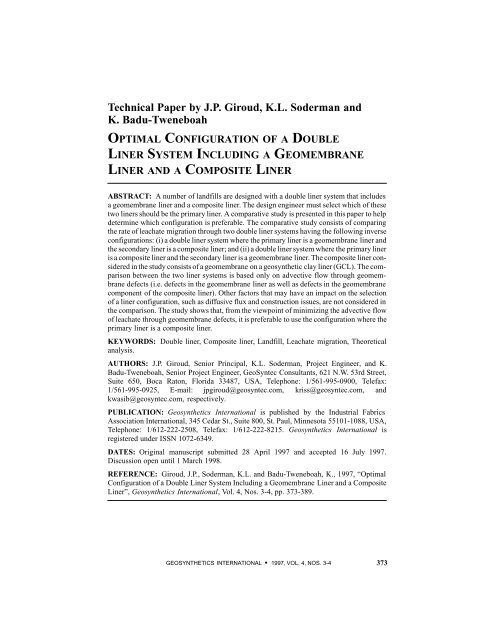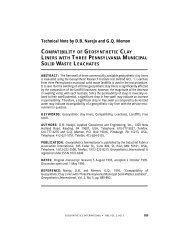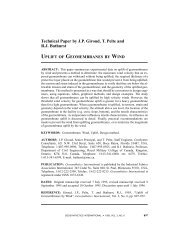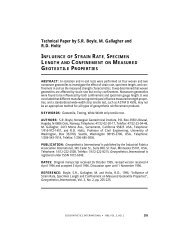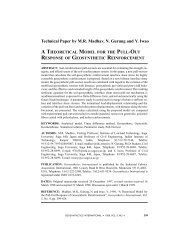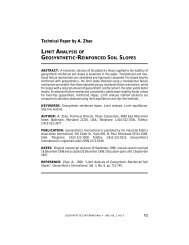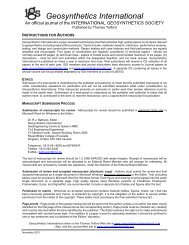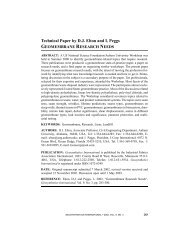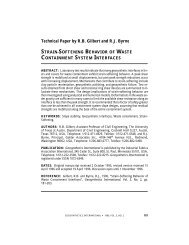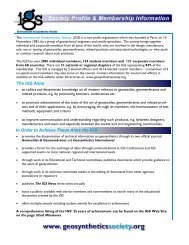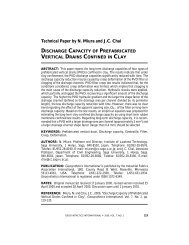Technical Paper by JP Giroud, KL Soderman and K. Badu-Tweneboah
Technical Paper by JP Giroud, KL Soderman and K. Badu-Tweneboah
Technical Paper by JP Giroud, KL Soderman and K. Badu-Tweneboah
Create successful ePaper yourself
Turn your PDF publications into a flip-book with our unique Google optimized e-Paper software.
<strong>Technical</strong> <strong>Paper</strong> <strong>by</strong> J.P. <strong>Giroud</strong>, K.L. <strong>Soderman</strong> <strong>and</strong><br />
K. <strong>Badu</strong>-<strong>Tweneboah</strong><br />
OPTIMAL CONFIGURATION OF A DOUBLE<br />
LINER SYSTEM INCLUDING A GEOMEMBRANE<br />
LINER AND A COMPOSITE LINER<br />
ABSTRACT: A number of l<strong>and</strong>fills are designed with a double liner system that includes<br />
a geomembrane liner <strong>and</strong> a composite liner. The design engineer must select which of these<br />
two liners should be the primary liner. A comparative study is presented in this paper to help<br />
determine which configuration is preferable. The comparative study consists of comparing<br />
the rate of leachate migration through two double liner systems having the following inverse<br />
configurations: (i) a double liner system where the primary liner is a geomembrane liner <strong>and</strong><br />
the secondary liner is a composite liner; <strong>and</strong> (ii) a double liner system where the primary liner<br />
is a composite liner <strong>and</strong> the secondary liner is a geomembrane liner. The composite liner considered<br />
in the study consists of a geomembrane on a geosynthetic clay liner (GCL). The comparison<br />
between the two liner systems is based only on advective flow through geomembrane<br />
defects (i.e. defects in the geomembrane liner as well as defects in the geomembrane<br />
component of the composite liner). Other factors that may have an impact on the selection<br />
of a liner configuration, such as diffusive flux <strong>and</strong> construction issues, are not considered in<br />
the comparison. The study shows that, from the viewpoint of minimizing the advective flow<br />
of leachate through geomembrane defects, it is preferable to use the configuration where the<br />
primary liner is a composite liner.<br />
KEYWORDS: Double liner, Composite liner, L<strong>and</strong>fill, Leachate migration, Theoretical<br />
analysis.<br />
AUTHORS: J.P. <strong>Giroud</strong>, Senior Principal, K.L. <strong>Soderman</strong>, Project Engineer, <strong>and</strong> K.<br />
<strong>Badu</strong>-<strong>Tweneboah</strong>, Senior Project Engineer, GeoSyntec Consultants, 621 N.W. 53rd Street,<br />
Suite 650, Boca Raton, Florida 33487, USA, Telephone: 1/561-995-0900, Telefax:<br />
1/561-995-0925, E-mail: jpgiroud@geosyntec.com, kriss@geosyntec.com, <strong>and</strong><br />
kwasib@geosyntec.com, respectively.<br />
PUBLICATION: Geosynthetics International is published <strong>by</strong> the Industrial Fabrics<br />
Association International, 345 Cedar St., Suite 800, St. Paul, Minnesota 55101-1088, USA,<br />
Telephone: 1/612-222-2508, Telefax: 1/612-222-8215. Geosynthetics International is<br />
registered under ISSN 1072-6349.<br />
DATES: Original manuscript submitted 28 April 1997 <strong>and</strong> accepted 16 July 1997.<br />
Discussion open until 1 March 1998.<br />
REFERENCE: <strong>Giroud</strong>, J.P., <strong>Soderman</strong>, K.L. <strong>and</strong> <strong>Badu</strong>-<strong>Tweneboah</strong>, K., 1997, “Optimal<br />
Configuration of a Double Liner System Including a Geomembrane Liner <strong>and</strong> a Composite<br />
Liner”, Geosynthetics International, Vol. 4, Nos. 3-4, pp. 373-389.<br />
GEOSYNTHETICS INTERNATIONAL S 1997, VOL. 4, NOS. 3-4<br />
373
GIROUD et al. D Optimal Configuration of a Double Liner System<br />
1 INTRODUCTION<br />
In many l<strong>and</strong>fills <strong>and</strong> other waste containment systems where a double liner system<br />
is used, the primary liner is a geomembrane <strong>and</strong> the secondary liner is a composite liner<br />
that consists of a geomembrane on a layer of compacted clay (Figure 1a). The inverse<br />
configuration where the geomembrane-compacted clay composite liner is the primary<br />
liner <strong>and</strong> the geomembrane used alone is the secondary liner (Figure 1b) is rarely considered<br />
because: (i) compaction of the clay could damage the geomembrane used as the<br />
secondary liner (<strong>and</strong> the geonet, if one is used in the secondary leachate collection layer);<br />
<strong>and</strong> (ii) regulations often prescribe the first configuration.<br />
Geosynthetic clay liners (GCLs) are increasingly used instead of compacted clay in<br />
composite liners. GCLs are usually installed with light equipment that should not damage<br />
the underlying geosynthetics. Therefore, when a GCL is used, both configurations<br />
can be considered: (i) the geomembrane alone as the primary liner <strong>and</strong> the geomembrane-GCL<br />
composite liner as the secondary liner (Figure 1c); <strong>and</strong> (ii) the inverse configuration<br />
(Figure 1d). A comparison between these two configurations is presented in<br />
this paper.<br />
It is realized that several criteria <strong>and</strong> approaches can be used to compare liner systems.<br />
However, only leachate migration due to advective flow of leachate through geomembrane<br />
defects is considered herein. The considered defects are defects in the geomembrane<br />
used alone as well as defects in the geomembrane component of the<br />
composite liner.<br />
The purpose of the comparison presented herein is to provide information that may<br />
be used as part of the process for selecting the optimal configuration for a double liner<br />
system.<br />
2 METHODOLOGY<br />
2.1 Approach<br />
The two double liner systems considered in the study are shown in Figure 2. For each<br />
of the two liner systems, the rate of leachate migration through the secondary liner is<br />
calculated according to the following four steps:<br />
S A given average head of leachate on top of the primary liner is considered.<br />
S The rate of leachate migration through the primary liner due to advective flow<br />
through defects in the primary liner geomembrane is calculated.<br />
S The average head of leachate on top of the secondary liner due to leachate that has<br />
migrated through the primary liner is calculated.<br />
S The rate of leachate migration through the secondary liner due to advective flow<br />
through defects in the secondary liner geomembrane is calculated.<br />
The rate of leachate migration through the secondary liner thus calculated is the rate<br />
of leachate migration into the ground.<br />
It is preferable to discuss leachate head calculation prior to discussing leachate migration<br />
calculations due to numerous references to leachate head in leachate migration cal-<br />
374 GEOSYNTHETICS INTERNATIONAL S 1997, VOL. 4, NOS. 3-4
GIROUD et al. D Optimal Configuration of a Double Liner System<br />
(a)<br />
P-L<br />
(b)<br />
P-L<br />
S-L<br />
S-L<br />
(c)<br />
P-L<br />
(d)<br />
P-L<br />
S-L<br />
S-L<br />
Materials<br />
Geomembrane<br />
Geosynthetic clay liner<br />
(GCL)<br />
Compacted clay<br />
Granular material<br />
Geonet (could be<br />
used instead of<br />
the granular material)<br />
Functions<br />
P - L : Primary liner<br />
S - L : Secondary liner<br />
P - LCL : Primary leachate collection layer<br />
S - LCL : Secondary leachate collection layer<br />
Composite liners<br />
Geomembrane - clay<br />
Geomembrane - GCL<br />
Figure 1. Double liner systems.<br />
Note: The small space between the GCL <strong>and</strong> the overlying geomembrane is shown only for clarity. In<br />
reality, a geomembrane <strong>and</strong> a GCL,which are associated toform a composite liner,should be in close contact.<br />
Filters are not shown for the sake of simplicity.<br />
culations. Accordingly, the method used to determine the average head of leachate on<br />
top of the secondary liner is described in Section 2.2, <strong>and</strong> the methods used to calculate<br />
leachate migration through liners are described in Section 2.3.<br />
2.2 Method for Calculating the Average Head of Leachate on Top of the<br />
Secondary Liner<br />
2.2.1 Influence of the Approach Used for Leachate Migration Evaluation on the<br />
Selection of a Relevant Leachate Head on the Secondary Liner<br />
As indicated in Section 2.1, a given value of the average head of leachate on top of<br />
the primary liner is considered. In contrast, the average head of leachate on top of the<br />
GEOSYNTHETICS INTERNATIONAL S 1997, VOL. 4, NOS. 3-4<br />
375
GIROUD et al. D Optimal Configuration of a Double Liner System<br />
(a)<br />
Gravel primary leachate<br />
collection layer<br />
Geomembrane primary liner<br />
Geonet secondary<br />
leachate collection layer<br />
Geomembrane - GCL composite<br />
secondary liner<br />
Permeable subgrade<br />
(b)<br />
Gravel primary leachate<br />
collection layer<br />
Geomembrane - GCL composite<br />
primary liner<br />
Geonet secondary<br />
leachate collection layer<br />
Geomembrane secondary liner<br />
Permeable subgrade<br />
Figure 2. The two double liner systems used in the comparative study: (a) double liner<br />
system where the primary liner is a geomembrane liner <strong>and</strong> the secondary liner is a<br />
composite liner; (b) double liner system where the primary liner is a composite liner <strong>and</strong><br />
the secondary liner is a geomembrane liner.<br />
Note: The terminology “geomembrane primary liner” means that the primary liner consists of a<br />
geomembrane used alone. The terminology “primary liner geomembrane” (used in the text) refers to the<br />
geomembrane of the primary liner whether it is used alone or in association with a GCL to form a composite<br />
liner. Filters are not shown for the sake of simplicity.<br />
secondary liner must be calculated based on the rate of leachate migration through the<br />
primary liner.<br />
Leachate migration through the primary liner occurs through a relatively small number<br />
of defects in the primary liner geomembrane. As a result, leachate flow in the secondary<br />
leachate collection layer takes place only in certain zones called “wetted” zones,<br />
i.e. zones of the secondary leachate collection layer <strong>and</strong> the secondary liner that are in<br />
contact with leachate that has migrated through the primary liner. If there are only a few<br />
defects, there is a wetted zone for each defect, but if the frequency of geomembrane<br />
defects in the primary liner is high, some of the wetted zones may overlap. The ratio<br />
376 GEOSYNTHETICS INTERNATIONAL S 1997, VOL. 4, NOS. 3-4
GIROUD et al. D Optimal Configuration of a Double Liner System<br />
between the combined surface area of the wetted zones <strong>and</strong> the total surface area of the<br />
liner is called the “wetted fraction” (<strong>Giroud</strong> et al. 1997a).<br />
The relevant average head of leachate on top of the secondary liner depends on the<br />
approach used for calculating the rate of leachate migration through the secondary liner.<br />
There are two possible approaches for calculating the rate of leachate migration through<br />
the secondary liner:<br />
S The first approach, which is the most rigorous, consists of: (i) calculating the combined<br />
surface area of the wetted zones due to leachate migrating through all of the<br />
defects in the primary liner; (ii) calculating the wetted fraction; (iii) calculating the<br />
average leachate head on top of the secondary liner in the wetted zones; (iv) calculating<br />
the rate of leachate migration through a defect in the secondary liner geomembrane,<br />
assuming the defect is in a wetted zone; <strong>and</strong> (v) multiplying the rate of leachate<br />
migration thus obtained <strong>by</strong> the wetted fraction <strong>and</strong> <strong>by</strong> the frequency of geomembrane<br />
defects in the secondary liner.<br />
S The second approach, which is only approximate, consists of: (i) assuming that all<br />
of the leachate migrating through the primary liner results in a uniform rate of liquid<br />
impingement over the entire surface area of the secondary leachate collection layer;<br />
(ii) calculating the average leachate head on top of the entire surface area of the secondary<br />
liner; (iii) calculating the rate of leachate migration through a defect in the<br />
secondary liner geomembrane; <strong>and</strong> (iv) multiplying the rate of leachate migration<br />
thus obtained <strong>by</strong> the frequency of geomembrane defects in the secondary liner. The<br />
second approach is similar to the first approach with a wetted fraction equal to one.<br />
The first approach, which is described in detail <strong>by</strong> <strong>Giroud</strong> et al. (1997a), is extremely<br />
tedious. The second approach is used herein. It is shown in the paper <strong>by</strong> <strong>Giroud</strong> et al.<br />
(1997a, at the end of Section 5.2.5 <strong>and</strong> in Section 6.1 after Example 6) that both approaches<br />
give rates of leachate migration of the same order of magnitude, <strong>and</strong> that the<br />
second approach is conservative, i.e. gives a head of leachate on top of the secondary<br />
liner that is greater than the head of leachate obtained with the first approach.<br />
2.2.2 Equation for Calculating the Average Head of Leachate on Top of the Secondary<br />
Liner<br />
Based on the fact that the second of the two approaches described in Section 2.2.1<br />
is selected, the average head of leachate on the secondary liner is calculated assuming<br />
that the rate of leachate impingement is uniform over the entire surface area of the secondary<br />
leachate collection layer. Accordingly, the following equation (<strong>Giroud</strong> <strong>and</strong><br />
Houlihan 1995) is used to calculate the average leachate head on top of the secondary<br />
liner:<br />
h<br />
2<br />
qi<br />
L q1<br />
L l L tanb<br />
= = =<br />
2 k tanb<br />
2 k tanb<br />
2<br />
2<br />
where: h 2 = average leachate head on top of the secondary liner; q i = uniform rate of<br />
leachate impingement onto the considered leachate collection layer (i.e., in this case,<br />
the secondary leachate collection layer), which, in this case, is equal to the unit rate of<br />
leachate migration through the primary liner, q 1 (defined in Section 2.3.3); L = horizon-<br />
2<br />
(1)<br />
GEOSYNTHETICS INTERNATIONAL S 1997, VOL. 4, NOS. 3-4<br />
377
GIROUD et al. D Optimal Configuration of a Double Liner System<br />
tal projection of the length of the liner system in the direction of the slope; k 2 = hydraulic<br />
conductivity of the secondary leachate collection layer material; β = slope angle of the<br />
liner system; <strong>and</strong> λ is a dimensionless parameter defined <strong>by</strong>:<br />
qi<br />
q1<br />
l = =<br />
2 2<br />
(2)<br />
k tan b k tan b<br />
2<br />
As indicated <strong>by</strong> <strong>Giroud</strong> <strong>and</strong> Houlihan (1995), Equation 1 is valid only if λ is small<br />
(e.g. λ < 0.01). This condition is always satisfied in the study presented in this paper.<br />
2.3 Methods for Calculating the Rate of Leachate Migration Through Liners<br />
2.3.1 Leachate Migration Mechanism<br />
As indicated in Section 1, the only mechanism of leachate migration through a liner<br />
(whether it is a geomembrane used alone or a composite liner) that is considered in this<br />
study is advective flow through defects in the geomembrane. The defects are defects<br />
in the geomembrane used alone as well as defects in the geomembrane component of<br />
the composite liner.<br />
2.3.2 Assumption<br />
For the leachate migration rate calculations, it is assumed that the leachate head on<br />
top of the considered liner is uniform over the entire surface area of the liner. Therefore,<br />
the rate of leachate migration through a geomembrane defect is independent of the geomembrane<br />
defect location in the considered liner.<br />
The uniform leachate head is equal to the given average head for the primary liners<br />
(see Section 2.1), <strong>and</strong> is equal to the average head calculated using Equation 1 for the<br />
secondary liners (see Section 2.2.2).<br />
2.3.3 Unit Rate of Leachate Migration Through a Liner<br />
Since it is assumed in Section 2.3.2 that the leachate head is uniform over the entire<br />
surface area of both the primary <strong>and</strong> secondary liners, the same methodology for leachate<br />
migration calculation applies to both liners. The methodology consists of: (i) calculating<br />
the rate of leachate migration, Q, through a geomembrane defect; <strong>and</strong> (ii) multiplying<br />
the rate of leachate migration through a defect <strong>by</strong> the geomembrane defect<br />
frequency, F, to obtain the unit rate ofleachate migration, q, through the considered liner:<br />
q = F Q<br />
(3)<br />
where the geomembrane defect frequency, F, is expressed as the number of defects per<br />
unit area (e.g. five defects per hectare, i.e. F =5× 10 -4 m -2 ). As a result, if Q is expressed<br />
in m 3 /s, q is expressed in m/s. Herein, the same geomembrane defect frequency, F, will<br />
be used for both the primary <strong>and</strong> secondary liners of a given double liner system, <strong>and</strong><br />
the following notations will be used for the rate of leachate migration through a defect<br />
<strong>and</strong> the unit rate of leachate migration through a liner: Q 1 <strong>and</strong> q 1 for the primary liner,<br />
<strong>and</strong> Q 2 <strong>and</strong> q 2 for the secondary liner.<br />
2<br />
378 GEOSYNTHETICS INTERNATIONAL S 1997, VOL. 4, NOS. 3-4
GIROUD et al. D Optimal Configuration of a Double Liner System<br />
Essentially, Equation 3 shows that the unit rate of leachate migration through a liner<br />
is derived from the rate of leachate migration through a geomembrane defect. The<br />
method used to calculate the rate of leachate migration through a geomembrane defect,<br />
Q, depends on the type of liner: a geomembrane liner, or a composite liner. These two<br />
cases are addressed in Sections 2.3.4 <strong>and</strong> 2.3.5, respectively.<br />
2.3.4 Rate of Leachate Migration Through a Defect in a Geomembrane Liner<br />
Traditionally, the rate of leachate migration through a geomembrane liner defect has<br />
been calculated using Bernoulli’s equation for free flow through an orifice:<br />
Q = 06 . a 2 g h<br />
(4)<br />
where: a = defect surface area; g = acceleration due to gravity; <strong>and</strong> h = leachate head<br />
on top of the liner.<br />
<strong>Giroud</strong> et al. (1997b) show that Equation 4 may give leachate migration rate values<br />
that are grossly exaggerated if the leachate head is relatively small <strong>and</strong>/or if the hydraulic<br />
conductivity of the leachate collection layer material overlying the liner is relatively<br />
small. In such cases, the following relationship exists (<strong>Giroud</strong> et al. 1997b):<br />
h<br />
R<br />
S|<br />
T|<br />
a qi<br />
Q Q<br />
= + ln - 1 +<br />
2 k p 2 k p a q<br />
L<br />
N<br />
M<br />
F<br />
HG<br />
i<br />
I<br />
KJ<br />
O<br />
Q<br />
P<br />
F<br />
HG<br />
1 Q<br />
2<br />
4 g 06 . a<br />
I K J<br />
U<br />
V|<br />
W|<br />
/<br />
4 12<br />
where: k = hydraulic conductivity of the leachate collection layer overlying the geomembrane;<br />
<strong>and</strong> q i = uniform rate of leachate impingement onto the leachate collection<br />
layer overlying the geomembrane.<br />
Equation 5 cannot be solved for Q; therefore, iterations are necessary to determine<br />
Q when h, a, k,<strong>and</strong>q i are known. Equation 5 is more general than Equation 4 <strong>and</strong> it tends<br />
toward Equation 4 for high values of h <strong>and</strong> k, as indicated <strong>by</strong> <strong>Giroud</strong> et al. (1997b). Herein,<br />
due to the values selected for the parameters (see Section 3.1), Equation 4 is applicable<br />
to the geomembrane primary liner. Therefore, in the study presented in this paper,<br />
it is not necessary to know the rate of leachate impingement onto the primary leachate<br />
collection layer (a parameter that is included in Equation 5, but not in Equation 4). This<br />
greatly simplifies the comparative study presented in Section 4.<br />
From the foregoing discussion, it appears that, in this study, Equation 5 needs to be<br />
used only for the secondary liner. Alternatively, the following equation, obtained <strong>by</strong><br />
combining Equations 2 <strong>and</strong> 5, can be used for the secondary liner:<br />
b g b g b g<br />
1= 2 p A 1+ C ln C- 1 + B C 06 .<br />
2 4<br />
where A, B, <strong>and</strong>C are dimensionless parameters defined as follows (<strong>Giroud</strong> et al.<br />
1997b):<br />
ak2<br />
tan 2 b<br />
A =<br />
(7)<br />
2<br />
q L<br />
1<br />
(5)<br />
(6)<br />
GEOSYNTHETICS INTERNATIONAL S 1997, VOL. 4, NOS. 3-4<br />
379
GIROUD et al. D Optimal Configuration of a Double Liner System<br />
B =<br />
q<br />
k tanb<br />
g L<br />
1 2<br />
(8)<br />
C =<br />
Q2<br />
aq<br />
1<br />
(9)<br />
Equation 6, like Equation 5, must be solved iteratively. However, Equation 6 is slightly<br />
more convenient than Equation 5 due to the use of dimensionless parameters <strong>and</strong> the<br />
availability of a graphical solution given in Figure 13 of the paper <strong>by</strong> <strong>Giroud</strong> et al.<br />
(1997b). In the comparative study presented in Section 3, the rate of leachate migration<br />
through the geomembrane secondary liner is calculated <strong>by</strong> solving Equation 6 iteratively<br />
for C <strong>and</strong>, then, using the following equation derived from Equation 9:<br />
Q<br />
= C a q<br />
2 1<br />
(10)<br />
The value of Q 2 thus obtained is then checked using Equation 5 with q i = q 1 , k = k 2<br />
<strong>and</strong> Q = Q 2 .<br />
2.3.5 Rate of Leachate Migration Through a Geomembrane Defect in a Composite<br />
Liner<br />
The rate of leachate migration through a composite liner, due to one defect in the geomembrane<br />
component of the composite liner, is calculated using the following equation<br />
(<strong>Giroud</strong> 1997):<br />
Q<br />
L F<br />
= 021 . 1+ 01 .<br />
H G<br />
NM<br />
h<br />
t<br />
s<br />
I<br />
KJ<br />
095 .<br />
O<br />
QP<br />
a h k<br />
01 . 09 . 074 .<br />
s<br />
where: t s = thickness of the soil component of the composite liner; <strong>and</strong> k s = hydraulic<br />
conductivity of the soil component of the composite liner.<br />
Equation 11 is the latest development of the work on the evaluation of leachate migration<br />
through composite liners initiated <strong>by</strong> <strong>Giroud</strong> <strong>and</strong> Bonaparte (1989) <strong>and</strong> continued<br />
<strong>by</strong> <strong>Giroud</strong> et al. (1989, 1992).<br />
(11)<br />
3 COMPARATIVE STUDY<br />
3.1 Presentation of the Comparative Study<br />
The two double liner systems that are used in the comparative study are shown in Figure<br />
2. Values of the relevant parameters are as follows:<br />
S The primary leachate collection layer material is gravel with a hydraulic conductivity,<br />
k 1 , greater than 0.1 m/s <strong>and</strong> a thickness sufficient to contain the maximum considered<br />
leachate head (0.1 m).<br />
380 GEOSYNTHETICS INTERNATIONAL S 1997, VOL. 4, NOS. 3-4
GIROUD et al. D Optimal Configuration of a Double Liner System<br />
S The secondary leachate collection layer material is a geonet with a hydraulic conductivity<br />
k 2 = 0.1 m/s <strong>and</strong> a thickness of 5 mm.<br />
S Two values of the average leachate head on top of the primary liner (i.e. in the primary<br />
leachate collection layer) are considered: h 1 =0.01m<strong>and</strong>h 1 =0.1m.<br />
S Two types of geomembrane defects are considered: (i) diameter, d =0.5mm(a =<br />
(1/16) π × 10 -6 m 2 ) with a frequency of 25 defects per hectare (F =2.5× 10 -3 m -2 );<br />
<strong>and</strong> (ii) diameter, d =2mm(a = π × 10 -6 m 2 ) with a frequency of 2.5 defects per hectare<br />
(F =2.5× 10 -4 m -2 ). In a given double liner system, the sizes <strong>and</strong> frequencies of<br />
defects in the two geomembranes are assumed to be the same; however, the defects<br />
are located at r<strong>and</strong>om.<br />
S The GCL, which is the soil component of the composite liner, has the following characteristics:<br />
thickness, t s = 7 mm; <strong>and</strong> hydraulic conductivity, k s =1× 10 -11 m/s. These<br />
characteristics are consistent with the GCL characteristics used <strong>by</strong> <strong>Giroud</strong> et al.<br />
(1997c). In particular, the hydraulic conductivity is typical of the hydraulic conductivity<br />
of a hydrated GCL permeated <strong>by</strong> water or a leachate that does not contain chemicals<br />
likely to increase bentonite hydraulic conductivity.<br />
S The considered liner system area is square, 50 m × 50 m in plan dimensions, with a<br />
2% slope in one direction (i.e. L = 50 m <strong>and</strong> tanβ = 0.02).<br />
Four cases are thus defined (two values of the average head <strong>and</strong> two types of defects).<br />
3.2 Detailed Calculations for One Case<br />
3.2.1 Values of the Parameters<br />
Detailed calculations are presented in Section 3.2 for one of the four cases defined<br />
in Section 3.1 in order to illustrate the methodology. The case considered in Section 3.2<br />
is characterized <strong>by</strong> a leachate head on top of the primary liner h 1 = 0.01 m, a defect diameter<br />
d = 2 mm (i.e. a defect area a = π × 10 -6 m 2 ), <strong>and</strong> a defect frequency of 2.5 defects<br />
per hectare (i.e. F =2.5× 10 -4 m -2 ). The values of the other parameters are as defined<br />
in Section 3.1.<br />
In the case considered in Section 3.2, as in any of the three other cases, two liner systems<br />
are considered: (i) a double liner system where the primary liner is a geomembrane<br />
liner (Figure 2a); <strong>and</strong> (ii) a double liner system where the primary liner is a composite<br />
liner (Figure 2b). For each of the two liner systems considered, the four steps identified<br />
in Section 2.1 are performed.<br />
3.2.2 Calculations for the Double Liner System Where the Primary Liner is a<br />
Geomembrane<br />
Average Head of Leachate on Top of the Primary Liner. The value assumed for the<br />
average head of leachate on top of the primary liner is h 1 =0.01m.<br />
Rate of Leachate Migration Through the Geomembrane Primary Liner. The methodology<br />
for calculating the rate of leachate migration through a geomembrane liner defect<br />
is described in Section 2.3.4. Equation 5 (i.e. the general equation) should be used unless<br />
GEOSYNTHETICS INTERNATIONAL S 1997, VOL. 4, NOS. 3-4<br />
381
GIROUD et al. D Optimal Configuration of a Double Liner System<br />
conditions are met for the simpler, but less general, Equation 4 (Bernoulli’s equation) to<br />
be applicable. According to Figure 6 of the paper <strong>by</strong> <strong>Giroud</strong> et al. (1997b), Equation 4<br />
is applicable fora defect with a diameter of2 mm <strong>and</strong> a leachate head on top of the primary<br />
liner of 0.01 m if the hydraulic conductivity of the leachate collection layer overlying<br />
the geomembrane liner is greater than 1 × 10 -1 m/s. According to Section 3.1, this condition<br />
is met. (It has also been checked that Equation 4 is applicable to the geomembrane<br />
primary liner in the three other cases considered in the comparative study.) Consequently,<br />
Equation 4 can be used as follows to calculate the rate of leachate migration through<br />
a defect in the geomembrane primary liner due to a leachate head of 0.01 m:<br />
Q 1<br />
= ¥ - 6<br />
(.)( 0 6 10 ) ()(. 2 9 81)(. 0 01) = 8.<br />
349 ¥ 10<br />
- 7 3<br />
p m /s<br />
The unit rate of leachate migration through the geomembrane primary liner is then<br />
calculated using Equation 3 as follows:<br />
q 1<br />
= ( 2. 5 ¥ 10 ) (8. 349 ¥ 10 ) = 2.<br />
087 ¥ 10<br />
- 4 - 7 -10<br />
m/s<br />
Average Head of Leachate on Top of the Secondary Liner. The methodology for calculating<br />
the average head of leachate is described in Section 2.2. The average head of<br />
leachate on top of the secondary liner due to the above calculated unit rate of leachate<br />
migration through the primary liner is calculated using Equation 1 as follows:<br />
-10<br />
( 2087 . ¥ 10 ) (50)<br />
h 2<br />
=<br />
= 2609 . ¥ 10<br />
( 2) ( 01 . ) ( 002 . )<br />
- 6 m<br />
Rate of Leachate Migration Through the Composite Secondary Liner. The methodology<br />
for calculating the rate of leachate migration through a composite liner due to a geomembrane<br />
defect is described in Section 2.3.5. The rate of leachate migration through<br />
the secondary liner resulting from the above calculated head is calculated using Equation<br />
11 as follows:<br />
L<br />
NM<br />
Q 2<br />
= 021 . 1+<br />
01 .<br />
= 4.<br />
044 ¥ 10<br />
F<br />
HG<br />
-15<br />
2.<br />
609 ¥ 10<br />
-3<br />
7 ¥ 10<br />
3<br />
m /s<br />
-6<br />
I<br />
KJ<br />
095 .<br />
O<br />
QP<br />
- - -<br />
( p ¥ 10 ) ( 2. 609 ¥ 10 ) ( 1 ¥ 10 )<br />
6 01 . 6 0. 9 11 0.<br />
74<br />
The unit rate of leachate migration through the composite secondary liner is then calculated<br />
using Equation 3 as follows:<br />
q 2<br />
= ( 2. 5 ¥ 10 ) ( 4. 044 ¥ 10 ) = 1011 . ¥ 10<br />
- 4 - 15 -18<br />
m/s<br />
382 GEOSYNTHETICS INTERNATIONAL S 1997, VOL. 4, NOS. 3-4
GIROUD et al. D Optimal Configuration of a Double Liner System<br />
3.2.3 Calculations for the Double Liner System Where the Primary Liner is a<br />
Composite Liner<br />
Average Head of Leachate on Top of the Primary Liner. The value assumed for the<br />
average head of leachate on top of the primary liner is h 1 =0.01m.<br />
Rate of Leachate Migration Through the Composite Primary Liner. The methodology<br />
for calculating the rate of leachate migration through a composite liner due to a geomembrane<br />
defect is described in Section 2.3.5. The rate of leachate migration through<br />
the primary liner resulting from a head of 0.01 m is calculated using Equation 11 as follows:<br />
L<br />
NM<br />
Q 1<br />
= 021 . 1+<br />
01 .<br />
F<br />
HG<br />
001 .<br />
7 ¥ 10<br />
-3<br />
I<br />
KJ<br />
095 .<br />
O<br />
QP<br />
-6 0. 1 0. 9 -11 0.<br />
74 -12<br />
3<br />
( p ¥ 10 ) ( 0. 01) ( 1 ¥ 10 ) = 7.<br />
744 ¥ 10 m /s<br />
The unit rate of leachate migration through the composite primary liner is then calculated<br />
using Equation 3 as follows:<br />
q 1<br />
= ( 2. 5 ¥ 10 ) ( 7. 744 ¥ 10 ) = 1936 . ¥ 10<br />
- 4 - 12 -15<br />
m/s<br />
Average Head of Leachate on Top of the Secondary Liner. The methodology for calculating<br />
the average head of leachate is described in Section 2.2. The average head of<br />
leachate on top of the secondary liner due to the above calculated unit rate of leachate<br />
migration through the primary liner is calculated using Equation 1 as follows:<br />
-15<br />
(. 1936 ¥ 10 )(50)<br />
h 2<br />
=<br />
= 2420 . ¥ 10<br />
( 2) ( 01 . ) ( 002 . )<br />
- 11 m<br />
Rate of Leachate Migration Through the Geomembrane Secondary Liner. Themethodology<br />
for calculating the rate of leachate migration through a geomembrane liner defect<br />
is described in Section 2.3.4. As shown <strong>by</strong> the graphical solutions published <strong>by</strong> <strong>Giroud</strong><br />
et al. (1997b), Equation 4 is not applicable for very small heads such as the above<br />
calculated head. Therefore, Equation 5 (or Equation 6, which is equivalent) must be<br />
used. Both Equations 5 <strong>and</strong> 6 must be solved <strong>by</strong> iterations. Due to the use of dimensionless<br />
parameters, Equation 6 is slightly more convenient than Equation 5. Therefore,<br />
Equation 6 will be used. The result will then be checked using Equation 5.<br />
The dimensionless parameter A is calculated using Equation 7 as follows:<br />
-6 2<br />
( p ¥ 10 ) ( 01 . ) ( 0. 02)<br />
A =<br />
= 259636 .<br />
-15 2<br />
( 1936 . ¥ 10 ) (50)<br />
The dimensionless parameter B is calculated using Equation 8 as follows:<br />
GEOSYNTHETICS INTERNATIONAL S 1997, VOL. 4, NOS. 3-4<br />
383
GIROUD et al. D Optimal Configuration of a Double Liner System<br />
B =<br />
-15<br />
(. 1936 ¥ 10 )( 01 .)( 0. 02)<br />
( 981 . ) (50)<br />
= 7.<br />
8940 ¥ 10<br />
-21<br />
The graphical solution presented in Figure 13 of the paper <strong>by</strong> <strong>Giroud</strong> et al. (1997b)<br />
confirms that Equation 4 is not applicable to this case, <strong>and</strong> shows that the value of the<br />
dimensionless parameter C that corresponds to the above values of A <strong>and</strong> B is approximately<br />
1.3. Using 1.3 as a starting value for iterations with Equation 6 gives, after several<br />
iterations:<br />
C = 13675 .<br />
Then, the rate of leachate migration through a defect of the geomembrane secondary<br />
liner is calculated using Equation 10 as follows:<br />
Q 2<br />
= ¥ - 6<br />
¥ - 15<br />
(. 13675)( 10 )(. 1936 10 ) = 8.<br />
3173 ¥ 10<br />
- 21 3<br />
p m /s<br />
The unit rate of leachate migration through the geomembrane secondary liner is then<br />
calculated using Equation 3 as follows:<br />
q 2<br />
= ( 2. 5 ¥ 10 ) (8. 3173 ¥ 10 ) = 2.<br />
079 ¥ 10<br />
- 4 - 21 -24<br />
m/s<br />
Equation 5 is then used as follows to check that the above calculated value of Q 2 is<br />
consistent with the value of h 2 calculated in the preceding step:<br />
h 2<br />
=<br />
R<br />
S<br />
T|<br />
-6 -15 -21 -21<br />
( p ¥ 10 ) ( 1936 . ¥ 10 ) 83173 . ¥ 10 83173 . ¥ 10<br />
+<br />
ln<br />
- 1<br />
-6 -15<br />
( 2) ( 01 . ) ( p)<br />
( 2) ( 01 . ) ( p)<br />
( p ¥ 10 ) ( 1936 . 10 )<br />
1<br />
+<br />
( 4) ( 981 . )<br />
2<br />
L<br />
NM<br />
-21<br />
83173 . ¥ 10<br />
-6<br />
(.)( 06 p ¥ 10 )<br />
O<br />
QP U V |<br />
4<br />
W|<br />
12 /<br />
L<br />
NM<br />
= 2420 . ¥ 10<br />
- 11 m<br />
This value of h 2 is identical to the value calculated in the preceding step, which indicates<br />
that the value of Q 2 calculated above is correct.<br />
Finally, it is interesting to repeat the last step using Bernoulli’s equation (Equation<br />
4), which was the method typically used to calculate the rate of leachate migration<br />
through a defect in a geomembrane liner prior to the development of Equation 5 (or<br />
Equation 6, which is equivalent) <strong>by</strong> <strong>Giroud</strong> et al. (1997b). In the case considered herein,<br />
Equation 4 can be used as follows:<br />
Q 2<br />
= ¥ - 6<br />
¥ - 11<br />
(.)( 0 6 10 ) ()(. 2 9 81)(. 2 420 10 ) = 41073 . ¥ 10<br />
- 11 3<br />
p m /s<br />
hence, using Equation 3:<br />
q 2<br />
= ( 2. 5 ¥ 10 ) ( 41073 . ¥ 10 ) = 1027 . ¥ 10<br />
- 4 - 11 -14<br />
m/s<br />
It appears that the value of q 2 calculated using Bernoulli’s equation (i.e. 1.027 × 10 -14<br />
m/s) is much greater than the value calculated using Equation 5 (i.e. 2.079 × 10 -24 m/s).<br />
O<br />
QP<br />
384 GEOSYNTHETICS INTERNATIONAL S 1997, VOL. 4, NOS. 3-4
GIROUD et al. D Optimal Configuration of a Double Liner System<br />
Furthermore, the use of Bernoulli’s equation gives an absurd result: a value of the unit<br />
rate of leachate migration through the secondary liner (q 2 = 1.027 × 10 -14 m/s) that is<br />
greater than the unit rate of leachate migration through the primary liner (q 1 = 1.936 ×<br />
10 -15 m/s). Therefore, great caution should be exercised when Bernoulli’s equation is<br />
used to predict or analyze the performance of a geomembrane liner: there are many<br />
cases where absurd results can be obtained. There are also cases where Bernoulli’s<br />
equation is applicable, such as the second step of Section 3.2.2. Detailed guidance is<br />
provided in the paper <strong>by</strong> <strong>Giroud</strong> et al. (1997b) for determining in which cases Bernoulli’s<br />
equation is applicable.<br />
3.3 Results of the Comparative Study<br />
The results of the comparative study conducted for the four cases defined in Section<br />
3.1 are presented in Table 1. The results are presented in two columns (Columns A <strong>and</strong><br />
B), so the results for the case where the primary liner is a geomembrane liner (Column<br />
A, Figure 2a) can be readily compared to the results for the case where the primary liner<br />
Table 1. Results of the comparative study presented in Section 3.1.<br />
Defect diameter <strong>and</strong><br />
frequency<br />
Quantity<br />
(unit)<br />
(Column A)<br />
Geomembrane primary liner<br />
Composite secondary liner<br />
(Figure 2a)<br />
(Column B)<br />
Composite primary liner<br />
Geomembrane secondary liner<br />
(Figure 2b)<br />
(Cell 1A) (Cell 1B)<br />
h 1 (m) 0.01 0.01<br />
q 1 (m/s) 2.09 × 10 -10 1.94 × 10 -15<br />
h 2 (m) 2.61 × 10 -6 2.42 × 10 -11<br />
d =2mm q 2 (m/s) 1.01 × 10 -18 2.08 × 10 -24<br />
F =2.5× 10 -4 m -2 (Cell 2A) (Cell 2B)<br />
h 1 (m) 0.10 0.10<br />
q 1 (m/s) 6.60 × 10 -10 3.04 × 10 -14<br />
h 2 (m) 8.25 × 10 -6 3.79 × 10 -10<br />
q 2 (m/s) 2.85 × 10 -18 6.36 × 10 -23<br />
(Cell 3A) (Cell 3B)<br />
h 1 (m) 0.01 0.01<br />
q 1 (m/s) 1.31 × 10 -10 1.47 × 10 -14<br />
h 2 (m) 1.63 × 10 -6 1.83 × 10 -10<br />
d =0.5mm q 2 (m/s) 5.02 ××10 -18 4.93 × 10 -23<br />
F =2.5× 10 -3 m -2 (Cell 4A) (Cell 4B)<br />
h 1 (m) 0.10 0.10<br />
q 1 (m/s) 4.13 × 10 -10 2.30 × 10 -13<br />
h 2 (m) 5.16 × 10 -6 2.88 × 10 -9<br />
q 2 (m/s) 1.42 × 10 -17 4.71 × 10 -21<br />
Notes: The methodology used to develop Table 1 is presented in Section 2 <strong>and</strong> detailed calculations are<br />
presented in Section 3.2. The most important result is q 2 , the rate of leachate migration through the secondary<br />
liner, i.e. the rate of leachate migration into the ground. F =2.5× 10 -4 m -2 = 2.5 defects per hectare = one defect<br />
per 4000 m 2 ;<strong>and</strong>F =2.5× 10 -3 m -2 = 25 defects per hectare = ten defects per 4000 m 2 .<br />
GEOSYNTHETICS INTERNATIONAL S 1997, VOL. 4, NOS. 3-4<br />
385
GIROUD et al. D Optimal Configuration of a Double Liner System<br />
is a composite liner (Column B, Figure 2b). Each of the four pairs of cells (1A - 1B, 2A<br />
- 2B, 3A - 3B, <strong>and</strong> 4A - 4B) corresponds to one of the four cases defined in Section 3.1.<br />
The first of these four pairs of cells is related to the case presented in detail in Section<br />
3.2. Each of these eight cells comprises four lines: one line for the result of each of the<br />
four steps defined in Section 2.1.<br />
Comparing Columns A <strong>and</strong> B in Table 1, it appears that calculated values of the rate<br />
of leachate migration into the ground (i.e. the rate of leachate migration through the<br />
secondary liner, q 2 ) are smaller when the primary liner is a composite liner <strong>and</strong> the secondary<br />
liner is a geomembrane liner than with the inverse configuration.<br />
4 DISCUSSION AND CONCLUSIONS<br />
4.1 Discussion of the Results<br />
4.1.1 Liner System Configuration<br />
The purpose of this paper was to compare two configurations of double liner systems:<br />
(i) a double liner system where the primary liner is a geomembrane <strong>and</strong> the secondary<br />
liner is a composite liner; <strong>and</strong> (ii) a double liner system where the primary liner is a composite<br />
liner <strong>and</strong> the secondary liner is a geomembrane. In the double liner systems used<br />
for the comparison, the composite liner consists of a geomembrane on a GCL (Figure<br />
2). The comparison was performed <strong>by</strong> calculating the rate of leachate migration due to<br />
geomembrane defects. The results of the calculations, presented in Table 1, show that<br />
the rate of leachate migration into the ground is significantly less with the second configuration<br />
(Figure 2b) than with the first (Figure 2a). Therefore, if a design engineer has<br />
to choose between the two double liner systems described above, it may be recommended,<br />
on the basis of the comparison presented in this paper, to use the composite<br />
liner as the primary liner <strong>and</strong> the geomembrane liner as the secondary liner. However,<br />
this recommendation is mostly applicable to the case where the composite liner consists<br />
of a geomembrane on a GCL. If the composite primary liner consists of a geomembrane<br />
on a layer of compacted clay, compaction of the clay component of a primary liner may<br />
damage the underlying geosynthetics, i.e. the geonet secondary leachate collection system<br />
<strong>and</strong> the geomembrane secondary liner, which would likely cause more leachate<br />
migration through the secondary liner.<br />
It should be remembered that, as mentioned in Section 1, the comparison presented<br />
in this paper is based on advective flow calculations. A different ranking of the liner<br />
systems might have been obtained if other migration mechanisms (such as diffusion)<br />
had been considered.<br />
4.1.2 Magnitude of Leachate Migration Rate<br />
The calculated rates of leachate migration into the ground (q 2 in Table 1) are extremely<br />
small. The largest value of q 2 calculated, 1.42 × 10 -17 m/s, is equivalent to 5 × 10 -3<br />
liters per hectare per year, which should cause virtually no pollution. However, it should<br />
be remembered that mechanisms of contaminant migration other than advective flow<br />
have not been considered in this study. Nevertheless, it is clear that double liner sys-<br />
386 GEOSYNTHETICS INTERNATIONAL S 1997, VOL. 4, NOS. 3-4
GIROUD et al. D Optimal Configuration of a Double Liner System<br />
tems, even with defects in the geomembranes, can provide a high level of protection<br />
of the environment.<br />
4.2 Discussion of the Methodology<br />
4.2.1 Leachate Migration Mechanism<br />
As mentioned in Sections 1 <strong>and</strong> 4.1.1, only one leachate migration mechanism has<br />
been considered in this study: advective flow through geomembrane defects. It would<br />
be interesting to perform a similar study considering contaminant migration <strong>by</strong> diffusion<br />
instead of, or in addition to, advective flow.<br />
4.2.2 Leachate Distribution in the Secondary Leachate Collection Layer<br />
As indicated in Section 2.2.1, an average head of leachate over the entire surface area<br />
of the secondary liner has been considered (which entails only simple calculations)<br />
instead of the more sophisticated approach which consists of calculating the fraction<br />
of the secondary liner that is “wetted” <strong>by</strong> leachate, calculating the rate of leachate<br />
migration through the secondary liner, <strong>and</strong> prorating to account for the fact that only<br />
a fraction of the defects in the secondary liner are in the wetted zones. However, as indicated<br />
in Section 2.2, the calculated rates of leachate migration should not be significantly<br />
affected <strong>by</strong> the approach used. As a result, the ranking of the liner system configurations<br />
should not be affected <strong>by</strong> the approach used.<br />
4.2.3 Leachate Head Magnitude<br />
The main consideration that may affect the validity of the calculations is the fact that<br />
the calculated leachate heads on top of the secondary liner are extremely small. Clearly,<br />
with the very small leachate heads, h 2 , shown in Table 1, capillarity <strong>and</strong> wettability may<br />
significantly affect leachate migration. Since the advective flow calculations presented<br />
herein do not take capillarity <strong>and</strong> wettability into account, they should be regarded as<br />
conventional calculations that are mostly useful to rank various liner configurations <strong>and</strong><br />
to determine an approximate order of magnitude of the rate of leachate migration.<br />
4.2.4 Use of Bernoulli’s Equation<br />
In the comparative study performed herein, great care is taken to use Bernoulli’s<br />
equation (Equation 4) only when it is applicable, <strong>and</strong> to use the more general Equation<br />
5 when Bernoulli’s equation is not applicable. Indeed, it is shown at the end of Section<br />
3.2.3 that using Bernoulli’s equation when it is not applicable can lead to incorrect <strong>and</strong><br />
even absurd results. This confirms the conclusions reached <strong>by</strong> <strong>Giroud</strong> et al. (1997b).<br />
There are, however, cases where Bernoulli’s equation is applicable. Guidance is provided<br />
<strong>by</strong> <strong>Giroud</strong> et al. (1997b) for determining in which cases Bernoulli’s equation is<br />
applicable.<br />
GEOSYNTHETICS INTERNATIONAL S 1997, VOL. 4, NOS. 3-4<br />
387
GIROUD et al. D Optimal Configuration of a Double Liner System<br />
ACKNOWLEDGMENTS<br />
The analysis presented in this paper was developed for the evaluation of an actual<br />
double liner system, <strong>and</strong> the support of GeoSyntec Consultants is acknowledged. The<br />
authors are grateful to K. Holcomb, N. Pierce, <strong>and</strong> S.L. Berdy for assistance during the<br />
preparation of this paper.<br />
REFERENCES<br />
<strong>Giroud</strong>, J.P., 1997, “Equations for Calculating the Rate of Liquid Migration Through<br />
Composite Liners Due to Geomembrane Defects”, Geosynthetics International,Vol.<br />
4, Nos. 3-4, pp. 335-348.<br />
<strong>Giroud</strong>, J.P. <strong>and</strong> Bonaparte, R., 1989, “Leakage through Liners Constructed with Geomembranes,<br />
Part II: Composite Liners”, Geotextiles <strong>and</strong> Geomembranes,Vol.8,No.<br />
2, pp. 71-111.<br />
<strong>Giroud</strong>, J.P. <strong>and</strong> Houlihan, M.F., 1995, “Design of Leachate Collection Layers”, Proceedings<br />
of the Fifth International L<strong>and</strong>fill Symposium, Vol. 2, Sardinia, Italy, October<br />
1995, pp. 613-640.<br />
<strong>Giroud</strong>, J.P., Khatami, A. <strong>and</strong> <strong>Badu</strong>-<strong>Tweneboah</strong>, K., 1989, “Evaluation of the Rate of<br />
Leakage through Composite Liners”, Geotextiles <strong>and</strong> Geomembranes, Vol. 8, No. 4,<br />
pp. 337-340.<br />
<strong>Giroud</strong>, J.P., <strong>Badu</strong>-<strong>Tweneboah</strong>, K. <strong>and</strong> Bonaparte, R., 1992, “Rate of Leakage Through<br />
a Composite Liner due to Geomembrane Defects”, Geotextiles <strong>and</strong> Geomembranes,<br />
Vol. 11, No. 1, pp. 1-28.<br />
<strong>Giroud</strong>, J.P., Gross, B.A., Bonaparte, R. <strong>and</strong> McKelvey, J.A., 1997a, “Leachate Flow<br />
in Leakage Collection Layers Due to Defects in Geomembrane Liners”, Geosynthetics<br />
International, Vol. 4, Nos. 3-4, pp. 215-292.<br />
<strong>Giroud</strong>, J.P., Khire, M.V. <strong>and</strong> <strong>Soderman</strong>, K.L., 1997b, “Liquid Migration Through Defects<br />
in a Geomembrane Overlain <strong>and</strong> Underlain <strong>by</strong> Permeable Media”, Geosynthetics<br />
International, Vol. 4, Nos. 3-4, pp. 293-321.<br />
<strong>Giroud</strong>, J.P., <strong>Badu</strong>-<strong>Tweneboah</strong>, K. <strong>and</strong> <strong>Soderman</strong>, K.L., 1997c, “Comparison of Leachate<br />
Flow Through Compacted Clay Liners <strong>and</strong> Geosynthetic Clay Liners in L<strong>and</strong>fill<br />
Liner Systems”, Geosynthetics International, Vol. 4, Nos. 3-4, pp. 391-431.<br />
NOTATIONS<br />
The basic SI units are given in parentheses.<br />
A = parameter defined <strong>by</strong> Equation 7 (dimensionless)<br />
a = defect surface area (m 2 )<br />
B = parameter defined <strong>by</strong> Equation 8 (dimensionless)<br />
C = parameter defined <strong>by</strong> Equation 9 (dimensionless)<br />
388 GEOSYNTHETICS INTERNATIONAL S 1997, VOL. 4, NOS. 3-4
GIROUD et al. D Optimal Configuration of a Double Liner System<br />
d = geomembrane defect diameter (m)<br />
F = geomembrane defect frequency (m -2 )<br />
g = acceleration due to gravity (m/s 2 )<br />
h = leachate head on top of the liner (m)<br />
h 1 = average leachate head on top of the primary liner (m)<br />
h 2 = average leachate head on top of the secondary liner (m)<br />
k = hydraulic conductivity of the leachate collection layer overlying the<br />
geomembrane (m/s)<br />
k s = hydraulic conductivity of the soil component of the composite liner (m/s)<br />
k 1 = hydraulic conductivity of the primary leachate collection layer material<br />
(m/s)<br />
k 2 = hydraulic conductivity of the secondary leachate collection layer<br />
material (m/s)<br />
L = horizontal projection of the length of the liner system in the direction of<br />
the slope (m)<br />
q = unit rate of leachate migration through the considered liner (m/s)<br />
q i = uniform rate of leachate impingement onto the considered leachate<br />
collection layer (m/s)<br />
q 1 = unit rate of leachate migration through the primary liner (m/s)<br />
q 2 = unit rate of leachate migration through the secondary liner, equal to the<br />
unit rate of leachate migration into the ground (m/s)<br />
Q = rate of leachate migration through a geomembrane defect (m 3 /s)<br />
Q 1 = rate of leachate migration through the primary liner due to a<br />
geomembrane defect (m 3 /s)<br />
Q 2 = rate of leachate migration through the secondary liner due to a<br />
geomembrane defect (m 3 /s)<br />
t s = thickness of the soil component of the composite liner (m)<br />
β = slope angle of the liner system (°)<br />
λ = parameter defined <strong>by</strong> Equation 2 (dimensionless)<br />
GEOSYNTHETICS INTERNATIONAL S 1997, VOL. 4, NOS. 3-4<br />
389


